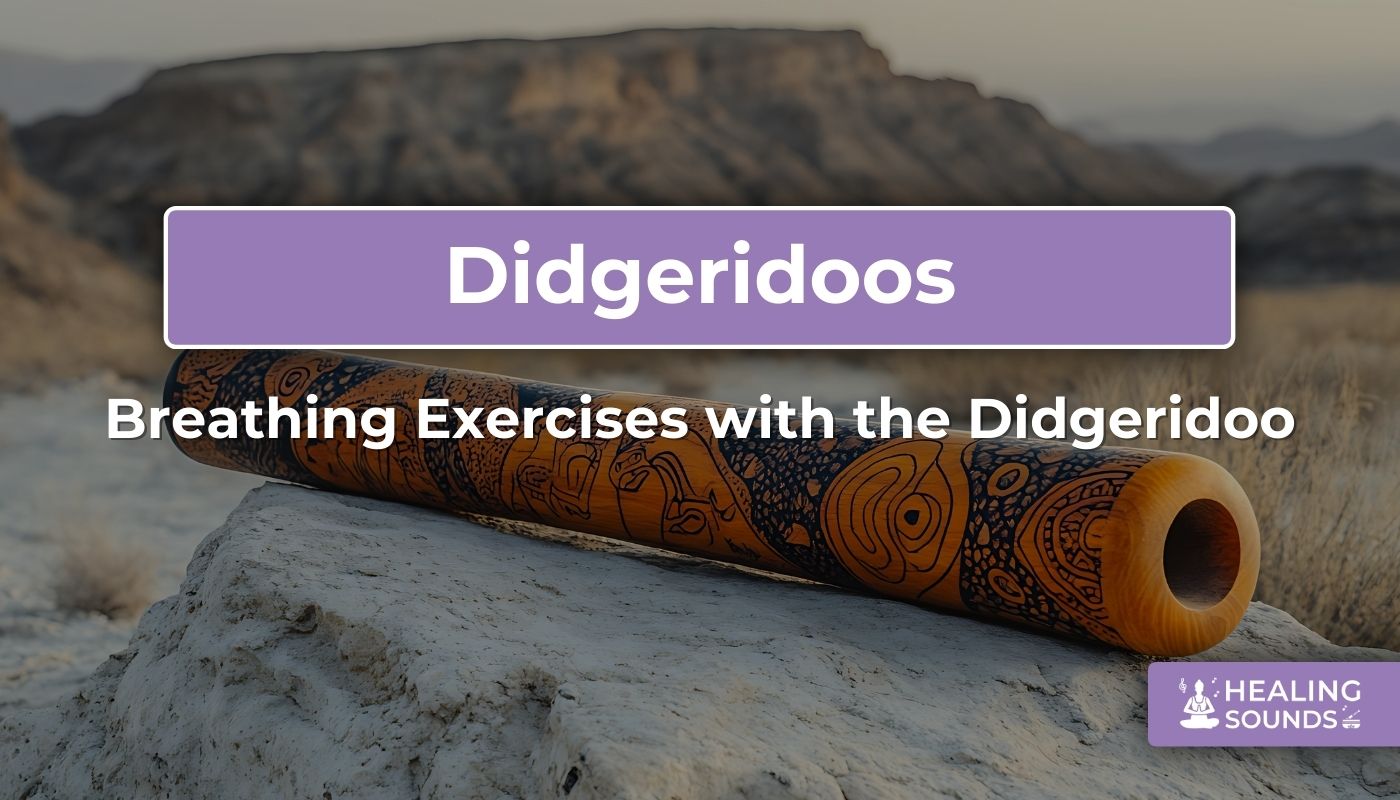Wenn Sie sich auf die Reise des Didgeridoo-Spielens begeben, verbinden Sie sich nicht nur mit der Musik, sondern auch mit alten Traditionen und kraftvoller Schwingungsheilung. Um dieses einzigartige Instrument zu meistern, sind spezielle Atemübungen mit dem Didgeridoo von zentraler Bedeutung. Für alle, die ihr Üben vertiefen, die Klangqualität verbessern und ihr allgemeines Wohlbefinden steigern möchten, ist das Verständnis und die Anwendung dieser Techniken unerlässlich. Dieser Leitfaden führt Sie durch grundlegende und fortgeschrittene Atemtechniken, wie z. B. die Zirkularatmung auf dem Didgeridoo , und zeigt Ihnen, wie Sie damit Ihre Lungenkapazität beim Didgeridoo deutlich steigern und Ihr Spielerlebnis bereichern können.
Die entscheidende Rolle des Atems beim Didgeridoo-Spielen
Wenn man zum ersten Mal das tiefe Dröhnen eines Didgeridoos hört, verliert man sich leicht in seinem resonanten Klang. Die Seele dieses Klangs entsteht jedoch durch kontrollierte, bewusste Atmung. Die richtige Atemkontrolle ist die Grundlage für alle anderen Didgeridoo-Techniken.
Im Gegensatz zu vielen anderen Blasinstrumenten benötigt das Didgeridoo einen kontinuierlichen Luftstrom, der oft durch spezielle Techniken erreicht wird. Durch die Beherrschung der Atmung können Sie die einzigartigen Klangstrukturen des Instruments beeinflussen und Rhythmen erzeugen, die die Natur widerspiegeln. Jeder Atemzug wird Teil der Musik.
Warum konzentrieren Sie sich so sehr auf die Atmung?
- Anhaltender Klang: Ermöglicht längere, ununterbrochene Bordune, die für die hypnotische Wirkung des Didgeridoos unerlässlich sind.
- Satte Töne: Verbessert die Qualität, Klarheit und Konsistenz der erzeugten Klänge.
- Meditativer Fluss: Fördert einen Zustand der Achtsamkeit und Entspannung und steht im Einklang mit dem Heilungspotenzial des Instruments.
Durch die Entwicklung einer starken Atemkontrolle wird das Spielen von einer einfachen Handlung zu einem tiefgreifenden Dialog zwischen Ihnen und dem Instrument.
Grundlegende Didgeridoo-Atemtechniken
Jeder Meisterspieler beginnt mit den Grundlagen. Bevor man sich an komplexere Methoden wie die Zirkularatmung wagt, ist es wichtig, eine solide Grundlage in der Atmung zu schaffen. Diese ersten Übungen konzentrieren sich auf Bewusstsein und Kontrolle.
Zwerchfellatmung: Der Ausgangspunkt
Die Zwerchfellatmung, oft auch „Bauchatmung“ genannt, ist von grundlegender Bedeutung. Dabei wird der Zwerchfellmuskel unterhalb der Lunge genutzt, um tiefere und effizientere Atemzüge zu erzielen, anstatt flach in der Brust zu atmen.
So üben Sie:
- Sitzen oder stehen Sie bequem mit gerader Wirbelsäule.
- Legen Sie eine Hand auf Ihre Brust und die andere auf Ihren Bauch, direkt unter Ihren Brustkorb.
- Atmen Sie langsam und tief durch die Nase ein und spüren Sie, wie sich Ihr Bauch nach außen ausdehnt. Ihre Brust sollte relativ ruhig bleiben.
- Atmen Sie langsam durch leicht geöffnete Lippen (oder das Didgeridoo-Mundstück) aus und spüren Sie, wie sich Ihr Bauch sanft zusammenzieht.
- Wiederholen Sie die Übung und konzentrieren Sie sich dabei auf einen gleichmäßigen, kontrollierten Rhythmus.
Diese Technik sorgt für den gleichmäßigen Luftstrom, der für den Dröhnklang des Didgeridoos erforderlich ist, und ist der Schlüssel zum Aufbau der Lungenkapazität des Didgeridoos .
Ausdaueraufbau mit Basisübungen
Einfache Übungen verbessern die Lungenausdauer. Üben Sie lange, langsame Einatmungen, gefolgt von ebenso langen, langsamen Ausatmungen ohne Instrument. Erhöhen Sie allmählich die Dauer beider Phasen und bleiben Sie dabei entspannt. Dies stärkt die Atemmuskulatur, die Sie für längere Spielsitzungen benötigen.

Didgeridoo, australisches Teakholzinstrument
$149.90 $209.90
Dieses aus hochwertigem Teakholz gefertigte Didgeridoo bietet eine hervorragende Resonanz und ist daher ideal zum Üben grundlegender Atemtechniken und zum Entwickeln eines starken Dröhnens.
Entdecken Sie dieses DidgeridooZirkularatmung für kontinuierlichen Klang meistern
Die Zirkularatmung ist die am häufigsten mit dem Didgeridoo assoziierte Technik. Sie ermöglicht es den Spielern, einen kontinuierlichen Klang ohne Unterbrechung aufrechtzuerhalten. Diese Fähigkeit ist entscheidend für fortgeschrittenes Spielen und eröffnet neue rhythmische Möglichkeiten.
Was ist Zirkularatmung?
Zirkularatmung ist der Vorgang, bei dem man durch die Nase einatmet und gleichzeitig die angesammelte Luft über die Wangen- und Zungenmuskulatur aus dem Mund ausatmet. Dadurch entsteht eine nahtlose Atemschleife, die ein kontinuierliches Dröhnen auf dem Didgeridoo ermöglicht. Stellen Sie es sich so vor, als würden Sie zwei separate Luftströme gleichzeitig steuern.
Schritt-für-Schritt-Anleitung zur Zirkularatmung
Das Erlernen der Zirkularatmung erfordert Geduld und Ausdauer. Wie lange dauert es? Es variiert stark, von Wochen bis Monaten, abhängig von der Regelmäßigkeit des Übens. Hier ist ein gängiger Ansatz:
| Schritt | Aktion | Fokus |
|---|---|---|
| 1 | Füllen Sie Ihre Wangen mit Luft, indem Sie sie sanft aufblasen. | Spüren Sie den Luftdruck in Ihren Wangen. |
| 2 | Verschließen Sie Ihre Lippen und halten Sie die Luft in Ihren Wangen. | Aufrechterhaltung der Versiegelung. |
| 3 | Während Sie die Luft in Ihren Wangen halten, üben Sie schnelle, kurze Einatmungen durch die Nase. | Trennung der Naseneinatmung von der Mundluft. |
| 4 | Drücken Sie die gespeicherte Wangenluft mithilfe Ihrer Wangen-/Zungenmuskulatur vorsichtig durch Ihre Lippen heraus (wobei Sie ein leises „Pfft“ oder Dröhnen erzeugen). | Erzeugen Sie ein kleines, kontrolliertes Ausatmen nur durch den Mund. |
| 5 | Kombinieren Sie die Schritte 3 und 4: Während Sie die Luft aus Ihren Wangen herausdrücken, atmen Sie schnell durch die Nase ein. | Die Koordination ist entscheidend. Fangen Sie langsam an! |
| 6 | Üben Sie mit einem Strohhalm im Wasser, um kontinuierliche Blasen zu sehen, und wechseln Sie dann zum Didgeridoo. | Visuelles/akustisches Feedback hilft, die Technik zu verfeinern. |
Dieser Vorgang beantwortet die häufig gestellte Frage: „ Wie atmet man beim Didgeridoo-Spielen? “, um einen kontinuierlichen Klang zu gewährleisten. Regelmäßige, kurze Übungseinheiten sind effektiver als seltene, lange.
Gesundheitsvorteile: Mehr als nur Musik
Die Atemübungen mit dem Didgeridoo bieten über die Entwicklung musikalischer Fähigkeiten hinaus erhebliche gesundheitliche Vorteile. Die Beschäftigung mit diesem Instrument kann sich sowohl positiv auf die körperliche als auch auf die geistige Gesundheit auswirken.
Steigerung der Lungenkapazität und Atemkraft
Ist Didgeridoo-Spielen gut für die Lunge? Ja. Die kontrollierte Atmung und Techniken wie die Zirkularatmung trainieren Ihre Atemwege. Regelmäßiges Üben stärkt das Zwerchfell und andere Atemmuskeln. Untersuchungen legen nahe, dass Didgeridoo-Spielen Beschwerden lindern kann, die mit einer Schwäche der Atemmuskulatur zusammenhängen. Eine im British Medical Journal veröffentlichte Studie ergab sogar, dass regelmäßiges Didgeridoo-Spielen durch die Stärkung der oberen Atemwegsmuskulatur Schnarchen und Tagesmüdigkeit bei Patienten mit mittelschwerem obstruktivem Schlafapnoe-Syndrom reduzierte ( Quelle: NCBI ). Dies steht in direktem Zusammenhang mit der Frage: Erhöht das Spielen eines Didgeridoos die Lungenkapazität des Spielers? Während es in erster Linie die Atemmuskulatur stärkt, trägt diese verbesserte Funktion zu einer effizienteren Atmung bei und verbessert so effektiv die Atemausdauer.
Stressabbau und Achtsamkeit
Die Rhythmik des Didgeridoo-Spiels, kombiniert mit konzentrierter Atmung, versetzt in einen meditativen Zustand. Die tiefen Vibrationen und das kontinuierliche Dröhnen können das Nervensystem beruhigen, Stress abbauen und Achtsamkeit fördern. Viele Spieler empfinden die Übungseinheiten als tief entspannend und zentrierend und bieten ein wirksames Mittel zur Förderung des geistigen Wohlbefindens.
- Stärkt die Atemmuskulatur.
- Kann die Atmungseffizienz verbessern (im Zusammenhang mit der Lungenkapazität).
- Fördert Entspannung und Stressabbau.
- Fördert Achtsamkeit und einen meditativen Zustand.
Verbessern Sie Ihre Praxis mit heilenden Klängen von Didgeridoos

179,90 €
249,90 €
Ideal für Klangheilung und Meditation. Die satten Töne unterstützen tiefe Atemübungen. Mehr erfahren ➔

149,90 €
209,90 €
Üben Sie Ihre Atemtechniken überall mit diesem kompakten, reisefreundlichen Spiral-Didgeridoo. Mehr erfahren ➔
Häufige Fallstricke und Tipps für den Erfolg
Das Erlernen der Didgeridoo-Atemübungen , insbesondere der Zirkularatmung, kann eine Herausforderung darstellen. Das Wissen um häufige Fehler hilft Ihnen, die Lernkurve reibungsloser zu meistern.
- Zu starkes Atmen: Zu starkes Atmen führt zu Anspannung und schlechtem Klang. Bleiben Sie entspannt.
- Inkonsistenz: Sporadisches Üben verlangsamt den Fortschritt. Streben Sie kurze, regelmäßige Sitzungen an.
- Grundlagen ignorieren: Vernachlässigen Sie die Zwerchfellatmung nicht, sie unterstützt alles andere.
- Zu früh aufgeben: Zirkularatmung braucht Zeit. Feiern Sie kleine Erfolge und seien Sie geduldig.
Tipps zur Verbesserung: Trinken Sie ausreichend, suchen Sie sich einen ruhigen Übungsplatz, nehmen Sie sich auf, um Ihren Fortschritt zu überwachen, und lassen Sie sich von erfahrenen Spielern oder Tutorials beraten.
Abschluss
Das Erlernen von Atemübungen mit dem Didgeridoo ist eine lohnende Erfahrung, die den musikalischen Ausdruck verbessert und das Wohlbefinden fördert. Von der grundlegenden Zwerchfellatmung bis hin zu den Feinheiten der Zirkularatmungstechniken des Didgeridoos – jeder Schritt stärkt Ihre Fähigkeiten und Ihre Verbindung zum Instrument. Regelmäßiges Üben verbessert nicht nur Ihren Klang und Ihre Ausdauer, sondern stärkt auch Ihre Atemwege und fördert die geistige Ruhe, was sich direkt auf Ihre Didgeridoo-Lungenkapazität und Ihr allgemeines Wohlbefinden auswirkt.
Entdecken Sie die vielfältige Auswahl an hochwertigen Didgeridoos bei Healing Sounds und finden Sie das perfekte Instrument, das Sie auf dieser Reise begleitet. Lassen Sie sich auf den Prozess ein, atmen Sie tief durch und lassen Sie die uralten Klänge fließen.
Häufig gestellte Fragen zu Atemübungen mit dem Didgeridoo
Beim Grundspiel wird für den Bordun die Zwerchfellatmung (tiefe Bauchatmung) verwendet. Für einen kontinuierlichen Klang erlernen die Spieler die Zirkularatmung , bei der sie durch die Nase einatmen und gleichzeitig die gespeicherte Luft aus den Wangen/dem Mund ausstoßen, um den Luftstrom in das Instrument ohne Unterbrechung aufrechtzuerhalten.
Ja, Didgeridoo-Spielen ist gut für die Atemwege. Es stärkt das Zwerchfell und andere Atemmuskeln und verbessert so die Ausdauer und Funktion der Atemmuskulatur. Studien deuten darauf hin, dass es bei Erkrankungen wie Schlafapnoe hilfreich sein kann, indem es die Muskeln der oberen Atemwege stärkt.
Bei der 5-5-5-Atemtechnik (oder Varianten der Boxatmung) atmet man fünf Sekunden lang ein, hält die Luft fünf Sekunden lang an und atmet fünf Sekunden lang aus. Obwohl es sich um eine nützliche allgemeine Entspannungstechnik handelt, unterscheidet sie sich von den spezifischen Methoden des kontinuierlichen Luftstroms, wie sie beispielsweise beim Didgeridoo-Spielen mit der Zirkularatmung erforderlich sind.
Die Zeit variiert erheblich von Person zu Person. Bei regelmäßigem täglichem Üben (selbst 10-15 Minuten) beherrschen manche die Grundlagen in wenigen Wochen, während das reibungslose Beherrschen des Didgeridoos mehrere Monate oder länger dauern kann. Geduld und Ausdauer sind der Schlüssel.
Auch wenn das Didgeridoo-Spielen das anatomische Lungenvolumen (die Gesamtlungenkapazität) nicht signifikant vergrößert, stärkt es doch die Atemmuskulatur. Diese verbesserte Muskelfunktion führt zu einer effizienteren Atmung und einer besseren Nutzung der vorhandenen Lungenkapazität. Dies erhöht die Atemausdauer, was oft als erhöhte Kapazität wahrgenommen wird.

